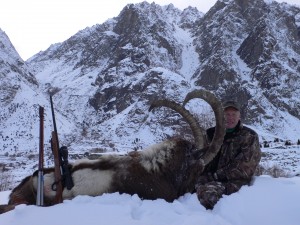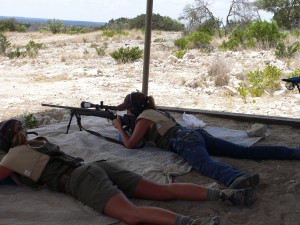
The 6.5mm, caliber .264, although never popular in the United States, has remained a European standby since the first military cartridges in that bullet diameter made their appearance in the early 1890s. I’m not generally reactionary by nature, but I’ve long had a soft spot for the 6.5mm. This is not altogether rational. As a kid in the 1960s, when magnums were in, I had a .264 Winchester Magnum, and I thought it was magic. I have another one today, so my preferred flavor in 6.5mm has run toward fast cartridges.
The .264 is a pretty rare bird, today just barely hanging on, but the Europeans also have a very fast 6.5mm, the unbelted 6.5×68. Faster than our .264, the 6.5×68 has its fans, but in Europe, milder 6.5s, including century old military rounds like the 6.5×55 Swedish Mauser, are actually more popular. Likewise over here. There’s a lot more interest in moderate 6.5s than there is in really fast magnums. Cartridge selection includes the old 6.5×55, the .260 Remington, and newer, efficient cartridges like the 6.5x.284 and Hornady’s 6.5 Creedmoor. I do understand cartridge efficiency, but I didn’t really get the attraction to the mild 6.5s, until I got my nose rubbed in it.
I was at one of the excellent ranges at Tim Fallon’s FTW Ranch in the Texas Hill Country. This particular range has steel gongs in 50-yard increments from 200 yards to well past 1000, and our goal that afternoon was to “walk” our rifles out as far as they would go. The primarily goal was to verify our reticles or turret adjustments, but shooting like that is also great practice for calling wind. I was shooting an accurate .300 Winchester Magnum, in theory a decent selection for such shooting. Gray Thornton, head of the Wild Sheep Foundation, and (as we like to believe, but haven’t proven), adistant cousin, was to my immediate left. He was shooting an out-of-the-box Ruger M77 in 6.5 Creedmoor.
Dialing our scopes to our respective trajectory curves, we both rang steel straight to 700 yards. The wind was tricky, so we were feeling pretty good about this. Then, on the 750-yard gong, my wheels came off. In fairness, I didn’t run out of cartridge or rifle accuracy; I ran out of scope. Gray, right next to me, dealing with the same wind, took that little Creedmoor (admittedly with a bigger, better scope) straight to 1000 yards. I finally got on the 750-yard gong, but I was done. Now intrigued, I borrowed Gray’s rifle and data,
and...
immediately hit the 1000-yard gong three times in a row, at which point I quit while I was ahead!

At long range, it would seem that velocity is important. Yes, it is, but only to a point. At extreme distance, it doesn’t much matter what you’re shooting; you still must deal with many feet (and quite a few yards) of bullet drop, so “flatness of trajectory” isn’t what matters. The 1000-yard guys tell me what is most important is to stay super-sonic all the way to the target as there is turbulence than can impact accuracy as the bullet drops below the speed of sound. Depending on temperature and humidity, that’s about 1126 feet per second.
That isn’t all that fast in terms of centerfire rifle velocity, but keeping that much speed out to 1000 yards isn’t just a matter of starting velocity; bullet aerodynamics that allow the bullet to hold as much speed as possible are important. 6.5mm bullets are traditionally heavy for caliber, expressed as Sectional Density (SD). Add aerodynamic design, like a sharp nose and boattail base, and a 140-grain 6.5mm bullet holds its velocity very well. You can start it at fairly modest velocity, like 2700 fps, and it will hold up very well. The same can be said of equally aerodynamic 7mm and .30-caliber bullets, except the 6.5mm can do it with less bullet weight, and thus less recoil which makes it easier to shoot well. A lot of 1000-yard competitors have turned to accurate, light-recoiling 6.5s, with favorites including the 6.5-.284 and the new 6.5 Creedmoor.
As hunters, we don’t care about 1000-yard performance, but heavy-for-caliber bullets also provide exceptional penetration on game. Scandinavian hunters understand this very well, often using their old 6.5x55s with 160-grain bullets for moose. Come to think of it, early 6.5mm military cartridges with 156 and 160-grain solids were used for game up to elephant. Today, we consider such cartridges dangerously light for the big stuff, but in the 1890s, when smokeless powder was new, these little cartridges delivered far greater penetration than the large-caliber blackpowder cartridges to which they were compared.
Today, I wouldn’t even think of using a 6.5mm on elephant, but its...
penetrating powers remain impressive. A 140-grain 6.5mm (.264-inch diameter) has Sectional Density (SD) of .287. A .270 bullet (.277-inch) in the same weight has SD of .261, and a 140-grain 7mm bullet (.284-inch) has SD of .246. This means if bullet construction is equal, the 140-grain 6.5mm will penetrate better in game than .270 and 7mm bullets of like weight. It’s true that the wound channel won’t be quite as large, and it’s also true that, on game, all of these differences are insignificantly small. But we American riflemen have largely overlooked the 6.5mm bullet diameter in favor of .270s and 7mms, and we might have been wrong all these years.

I hate to admit it, but earlier this year, whenmy 15-year-old daughter, Caroline, wantedto shoot a wild hog, I didn’t have a suitablerifle. She’s right-hand and fairly short, whileDonna and I are left-handed, so either theactions were backwards, or the stocks weretoo long, or both. A friend, August Harden,loaned us his daughter’s rifle, a Ruger M77 youth model in .260 Remington. Stoked with 140-grain Barnes Triple Shock, this little riflehas accounted for everything up to elk with no questions asked. On Caroline’s pig, that little 6.5mm bullet, at a modest velocity of about 2600 fps, broke both shoulders and kept going. Sure, many cartridges, calibers, and bullets would have done exactly the same. Where the bullet is placed is almost always more important than the bullet’s precise dimensions. But the more I’m around the 6.5mms, the less I understand why that caliber isn’t more popular.